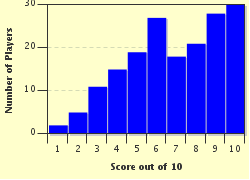Quiz Answer Key and Fun Facts
1. This animal has an unusually long tongue extending into the abdominal cavity, enabling it to eat insects without teeth or chewing. Which night roller is covered with hard keratin scales?
2. Found in Australia and surrounding areas, these night risers look like squirrels, with big eyes for night views, and swiveling ears. Which possum eats insects and tree sap, seeming to fly from tree to tree?
3. This familiar and slimy night crawler can get itself home, but only at six inches a minute. Which gastropod carries its shell along, as it cleans up dead plants and fungi?
4. Running in a band, pack or rout, the nocturnal American jackal, or coyote, expands its range to fill a niche left by which oft exterminated yet legendary night roamer?
5. Welcome the bat, who can eat around 1,000 mosquito-size insects in just an hour! It's the only mammal who naturally and truly does what?
6. Living in South America, the paradoxical frog is a puzzle to scientists. Also called the shrinking frog, mom frog must be stunned when her tadpoles are what?
7. This cute Asian primate with big eyes and opposable thumbs can stay completely still for hours on end. Which venomous animal is famous for being such a poke?
8. We can smell this one a mile away! Skunks are crepuscular, meaning they favor dusk and dawn as well as the deep of night. At birth, every skunk has what? Even Pepe Le Pew has this.
9. The aye-aye is a primate related to apes and humans, spending the day curled up in the trees of the rain forest. This rare animal is found only on which bio-diverse island, which has a red, white and green flag?
10. The cockroach chooses where to hang out based on how dark and moist an area is, as well as how many cockroaches have already been there. If you never want to see a cockroach again, go to the arctic areas, or else to which locations?
Source: Author
Godwit
This quiz was reviewed by FunTrivia editor
Tizzabelle before going online.
Any errors found in FunTrivia content are routinely corrected through our feedback system.

